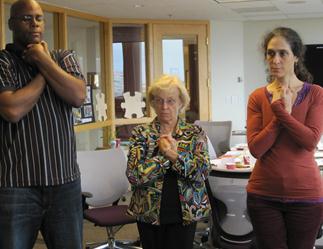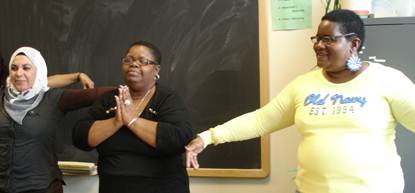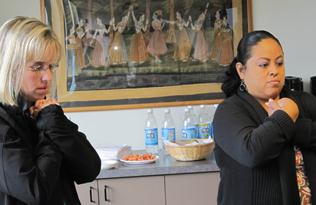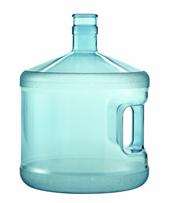 |
 |
|
the mind and The body
Women at Project Hope participate in a yoga class. In her book, A Settled Mind: Stress Reduction for the Classroom and Beyond, Kimberly Rowe (2007) states: In this current objectivist climate, education continues to struggle with the fragmentation of the learning process. Mind-body techniques have the potential to heal this rift because these practices acknowledge the physical, emotional, and spiritual influences on learning...As breath, body, and mind begin to settle, students are better able to listen to themselves, become attuned to their bodies, and express authentic feelings, not just emotional reactions...Attending to students' energy levels and emotional well-being as part of classroom practices can enhance the learning that takes place and is consistent with the prevailing theory of embodied learning, where the body is recognized as a source of knowledge. Mind/body practices and movement activities are particularly valuable for students who have experienced trauma. Research suggests that the experience of trauma lives in the body; helping to center the body can help students focus on learning. We have so little time to do so much in our classrooms. Is it really possible to add mind/body practices into an already over-crowded curriculum? I like to think of these strategies not as ways to involve the whole student in the learning process and as a way to maximize the impact of each class content. In this section we will look at some of the ways teachers have successfully integrated mind/body practices and movement activities into the classroom. When the teacher is attuned to her own and the students’ energy level in the class, she can select activities that help "up-regulate" or increase energy and attention, those that promote soothing and calming, or those that prompt laughter and joy. Meditation has continued to be a positive experience for the students, with them frequently staying late in order to do it. Even four minutes completely changes how people feel and leave the class much, much, more calm. Resources
Read about how Project Hope incorporated a yoga project into their Women of Strength class in her article Breathing and Balancing: Yoga in the Classroom. In my own life, I've been in a class recently where the instructor begins each class with a body scan/guided meditation. I look forward to it and expect it, and this teaches me that it is valuable to do the same activity again and again. I don't need to struggle to switch it up all of the time, and that rather, there is value in the consistency. Lisa Gimbel has developed a well-thought out lesson for a Guided Meditation to use with students, paying attention to preparing students and reflecting on her experience in fine tuning the process.To help students let go of the stress that accompanies them into the classroom, teachers experimented with “Letting Go” rituals as a way to begin class. Check out the following lesson plans for samples of these rituals:
Brain Gym
Brain Gy
 m refers to a set of exercises developed by Paul and Gail Dennison, based on their work in educational kinesiology. The premise of brain gym is that certain exercises involving cross lateral movements can help promote more balanced neural connections between both sides of the brain, enhancing concentration, focus, cognition, and a sense of well-being. Interdisciplinary in nature, Brain Gym has elements in common with some Eastern practices such as acupressure and yoga. For more information about Brain Gym, please see Brain Gym International. m refers to a set of exercises developed by Paul and Gail Dennison, based on their work in educational kinesiology. The premise of brain gym is that certain exercises involving cross lateral movements can help promote more balanced neural connections between both sides of the brain, enhancing concentration, focus, cognition, and a sense of well-being. Interdisciplinary in nature, Brain Gym has elements in common with some Eastern practices such as acupressure and yoga. For more information about Brain Gym, please see Brain Gym International.
Sitting P.A.C.E. for anxiety attacks (link to Youtube) P.A.C.E. for anxiety attacks (link to Youtube)
Read what Sally Daniels’ students had to say about participating in the PACE routine as part of their college transitions class: Rob: PACE is Positive Action Clear Energetic exercises to help you learn more effectively. We started off with drinking water to hydrate our bodies we need water to make connections faster in our brain. We then massaged our lymph nodes on our chest to move toxins to where they can be removed from our body. This also sends oxygen to our brains to make connections. We then do our cross crawl exercises. This is to get you moving and to make both sides of your brain to communicate with one another. We then do hookups; cross our legs and arms and fingers and close your eyes. Think of a nice quiet relaxing place you can picture in your mind. Stay at this place for five to ten minutes. I try to use PACE as often I can it seems to get my mind going and things come to me easier when I use this prior to studying. I rub my chest while studying to get my mind going, it seems to help. Hydration and Snacks to Promote Well Being in Class
After reading about the importance of hydration for health and clear thinking, teachers in the program began offering water to students at each class. A simple container of tap water and cups is a minimal way to ensure students are hydrated, which improves well-being and learning. Some teachers used disposable cups; others asked students to bring labeled cups for re-use. Programs could supply reusable water bottles as part of a lesson on health or at a health fair. Teachers in the program also discussed the importance of water for stress reduction and health. For resources on water and health, please see: http://nutrition.about.com/od/hydrationwater/a/waterarticle.htm Snacks Michelle Harris, a licensed therapist and consultant to the project, also suggested keeping a bowl of Cinna-mints or peppermints in class for drowsy students. These provide sensory stimulation and help some students focus when they are tired.
|
| New England Literacy Resource Center |
Copyright 2008 World Education, Inc.
Comments/Questions? Email us at wei@worlded.org

 Teachers in the Managing Stress to Improve Learning Project have integrated some of the Brain Gym movements into their classrooms, especially the PACE sequence, as a way to help students settle into class and focus on their learning tasks. PACE, which stands for Positive Action, Clear Energetic, is a short routine easily incorporated to the classroom. It is also fairly easy to remember and internalize as a tool for self-regulation for individuals whenever they need it.
Teachers in the Managing Stress to Improve Learning Project have integrated some of the Brain Gym movements into their classrooms, especially the PACE sequence, as a way to help students settle into class and focus on their learning tasks. PACE, which stands for Positive Action, Clear Energetic, is a short routine easily incorporated to the classroom. It is also fairly easy to remember and internalize as a tool for self-regulation for individuals whenever they need it.  Hydration
Hydration